Ancient High Technology and Hidden Energies of
|
Tour Costs: |
£400/£300 GBP deposit to confirm your place This will be converted into your currency at checkout. |
Main Greece Tour - Proposed Itinerary
Day 1 - Wednesday 7th October: We will pick you up in a minibus at Athens airport and take you to our hotel in the historic centre of Athens. Welcome dinner included and orientation and lecture by Hugh Newman and Gary Biltcliffe.

Day 2 - Thursday 8th October: An exploration of the Acropolis and its museum, The Acropolis is a rocky hill in the centre of Athens with three temples: the Parthenon, the Erechtheum and the Temple of Athena. The Parthenon is a temple dedicated to goddess Athena Parthenos (Athena the Virgin) and is a remarkable contruction. The Acropolis rises 490 feet (150 metres) into the sky above the city and has a surface area of approximately 7 acres (3 hectares). The site was a natural choice for a fortification and was inhabited at least as early as the Mycenaean Period in Greece (1900-1100 BC) if not earlier. We will also visit the Acropolis Museum and in the afternoon we visit Keramiklos, a temple site that has polygonal walls.

Day 3 - Friday 9th October: Today wisit the huge cyclopean stone wall of Pynx and the Hill of the Nymphs with remarkable stone carving and evidence of ancient technology. It is located less than a kilometre from the Acropolis. It is classed as a retaining wall for the Athenians who gathered on the Pnyx to host their popular assemblies, thus making the hill one of the earliest and most important sites in the creation of democracy. It is also called the Hill of the Nymphs and the Hill of the Muses. The Nymphs are sometimes referred to as giants, and this style of wall is often credited to the legendary Cyclops, one-eyed giants who ruled Greece before the Olympian gods. It is said to be dated to no earlier than 350 BC, but other similar polygonal structures in Greece, such as the Hellinikon Pyramid near Argos have revealed dates of around 2720 BC. The Pnyx Wall has gigantic blocks, some weighing over 60 tons with a 'puffy' style similar to the walls of Cuzco, Peru. The blocks have careful shaping similar to those found in Baalbek and Byblos in Lebanon. There are also intricately carved rock outcrops, doorways and niches above the wall and surrounding the hill. Again, these are similar to those in South America.
After lunch we drive west towards Argos stopping of at the Corinth Canal, again showing megalithic technology at its base. The canal was initially proposed in classical times. Several rulers of antiquity dreamed of digging a cutting through the isthmus. The first to propose such an undertaking was the tyrant Periander in the 7th century BC. Another failed effort was made to build it in the 1st century AD, finally being completed in the 19th century. However, evidence of megalithic construction has been found at its lowest levels. We will also visit Larissa Castle in Argos that is said to be the earliest megalithic construction in Greece, that also has Myceneaun influences in parts of the site. Not much survives from the cyclopean acropolis that Danaos was said to have built. Subsequent residents restructured and re-fortified the top of the hill. In the 6th-5th centuries BC, the Argives repaired and maintained the cyclopean walls. There still exist the remains of a massive stone construction at the foot of the walls that refer to that ancient time. In the 10th century the Byzantines built a castle on top of the existing walls and in the 13th century the Franks added another castle on top. But the name Larissa, given to the acropolis by Danaos, survives to this day.

Day 4 - Saturday 10th October: Visit the mighty complex of Tiryns, and the massive site of Mycenae. The second most important acropolis of the Mycenaean world was Tiryns, even though its cyclopean walls are even more impressive than Mycenae. According to tradition, they were built by Proetus, prince of Argos (great-grandson of Danaos) with help from the Cyclopes. When Pausanias visited the site several centuries later, he observed that not even a pair of mules could move the smallest stone of the walls, as each weighs 12-13 tons and is 3m long! Building began sometime in the 14th c. BC. The walls are 8m thick and 13m high. But archaeologists have unearthed an even older construction of the Danaid builders. A mysterious circular building, 28m in diameter, that was built on the hill at Tiryns between 2700BC and 2200BC – exactly the same time as the pyramids of the Argolid. Only the foundations have survived, but it was believed to be very tall as it was supported by 44 buttresses. This building was destroyed by a fire which burned all its secrets. The walls were finished by the end of the 13th c. BC, enclosing a space of 20,000 m2. At that time, the sea reached all the way to the bottom of the hill. Within the acropolis was built a large palatial complex, centered on the king’s Megaron and a grand court surrounded by columns. Within the Megaron were the King’s throne and the hearth. The rooms were decorated with colourful murals, depicting scenes from everyday life, hunting and nature. Here the King received his subjects and royal guests, here he was informed of the wealth of his realm in clay tablets written in Linear B script and here, according to the legends, King Eurystheus received Heracles to charge him with one of his superhuman Labours. Adjacent to the Megaron was the Bathroom for ceremonial use. Its floor consists of a huge limestone slab weighing 20 tons. One wonders what mechanical means were used to haul that slab all the way up the hill, and for what purpose. Why was such a stone so important to their rituals?

The Mycenean civilization begins just before 1600BC and is centered in the Argolid. Legend has it that Mycenae was built by Perseus, the son of Danae, grandson of the King of Argos Acrisius, who was a great-grandson of Danaos. One day, as he was wandering the countryside, Perseus got thirsty and stooped to cut a mushroom (mycetas in Greek). Underneath it he found a spring, which is still called Perseia. Perseus decided to build a city nearby and called Mycenae, from the lucky mushroom that revealed the spring to him. Construction began at the walls of Mycenae around 1400BC. They contain and guard an area of 30,300m2, reaching heights of 12m and width of 7.5m. In some places the wall is 14m thick and contains tunnels and passages, as well an an underground cistern that is still in existence. In the beginning, the construction of the walls parallels that of the cyclopean walls in Italy. Huge, irregular boulders fitted perfectly together without the use of mud, cement or other binder. Later, the construction changes to shaped rectangular stones. On top of the acropolis of Mycenae was the king’s palace, whose internal structured displays Minoan influences. Within the walls were treasuries, workshops, storage rooms, baths, temples and houses for the elite. Outside the walls there was the lower city, with approximately 30,000 inhabitants. The most imposing Mycenaean structure is, undoubtedly, the Tholos Tomb of Atreus, the best preserved of all tombs found in Mycenae. It was called the Treasury of Atreus already by the time of Pausanias. It was built sometime between 1350BC and 1250BC as the tomb of a very important king.

Day 5 - Sunday 11th October: Today we visit the most complete remaining pyramid in Greece. The Hellinikon Pyramid near Argos is. dated to around 2720 BC, older than the pyramids of Egypt. It has polygonal stonework like that in Peru, Italy and other parts of Greece and is one of 16 pyramids that once existed in the Argoloid Plain. We do not know the purpose for which the Argolid pyramids were built. Suggestions by experts include tombs of heroes or warriors, temples, guard quarters or signal towers. However, no bones have ever been found to suggest a tomb, while Mycenean guard towers were rectangular and not pyramidal in shape.The pyramid of Hellenikon may have been a sanctuary, as proposed by the civil engineer V. Katsiadramis, who performed a structural survey. The inner chamber was probably a space for pilgrimage and rituals and it possibly contained an altar for animal sacrifices. Maybe it also functioned as an initiation space, due to the high concentration of energy within the pyramid. Therefore, they had a similar function to the megalithic Nuraghi of Sardinia. We will also visit the Mycenean Tholos Tombs and further sites that have precision engineered polygonal stonework such as a remarkable megalithic hillfort complex of Midea.
Midea was the third most important city of the Mycenaean world. Located halfway between Mycenae and Tiryns, it was perfectly situated to control a large portion of the Argolid plain. Tradition claims that its walls were built by Perseus, a descendant of Danaos. Heracles, great-nephew of Perseus, born and bred in Midea, was therefore also a Danaid. The walls were constructed on three sides of a 270m tall hill, the fourth side being too steep to need them, and enclosed a space of 24,000m2. There were two opposing gates on the eastern and western sides. Within the western side wall a megalithic tunnel leads to a fresh water spring. The acropolis contained many rooms, most of which were workshops and storage spaces. There is an underground warren of rooms. The seat of the King was the Megaron, an oblong building on top of the acropolis. The word Megaron was found inscribed in a clay tablet in Linear B script. Midea seems to be the most important artistic and manufacturing site of the Argolid. A wealth of finds proves this – jewels and jewel molds, beads of semi-precious stones (agate, quartz, carnelian and fluorite), sword hilts of ivory and alabaster, bronze and stone tools, and a plethora of vases and amphorae.
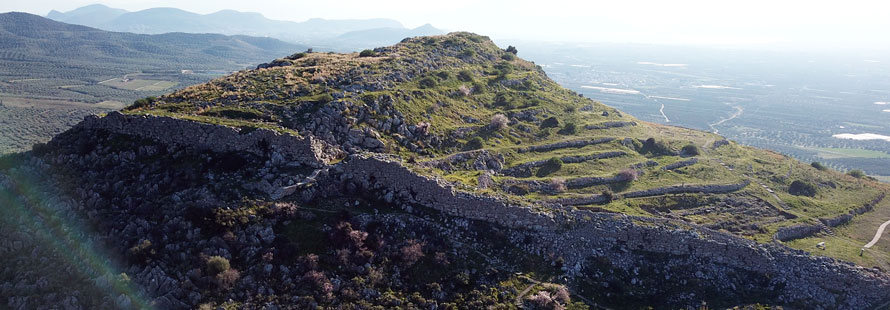
Day 6 - Monday 12th October: Today we drive North to the remarkable megalithic complex with a famous semi-circular theatre of Oiniades. Approaching the ancient theatre up the cliff, surrounded by oaks, it’s difficult to imagine the city that used to be here. And yet there, near the Acheloos estuary, used to be the acarnian city of Oiniades, heavily fortified since the 5th century. The city was located in a strategic position and had ports, in one of which used to be shipyards, places where ships were hauled, repaired and kept. An important monument of the place is the ancient theatre, whose largest part is carved into natural rock, while the rest is built of massive limestone blocks. The ancient theatre is still in operation, hosting many performances every summer. Continue to Parga. Overnight Parga.
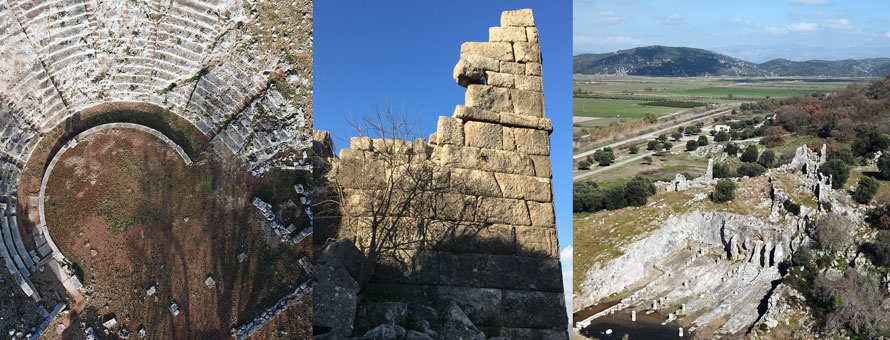
Day 7 - Tuesday 13th October: Dodona and Elea Archaeological sites. Dodona is an important ancient Greek oracle, second in fame only to Delphi. It is located in a strategic pass at the eastern slopes of the imposing Mt. Tomaros, close to the modern city of Ioannina in western Epiros. It was dedicated to Zeus and Dione, and the Greeks believed it to be the most ancient of oracles. It also sits upon the great 'Apollo/Athena' line and is exactly one degree of latitude above Delphi, suggesting it was part of a great survey, that also has powerful earth energy currents. Elea is a remarkable fortified settlement of the Late Classical and the Hellenistic periods, located at Paramythia, on the slopes of Mt. Corilas. The city was enclosed by massive polygonal walls, over one mile long, with the main monumental gate on the east side. In legend the 'cyclopes' built the site. Overnight Parga.
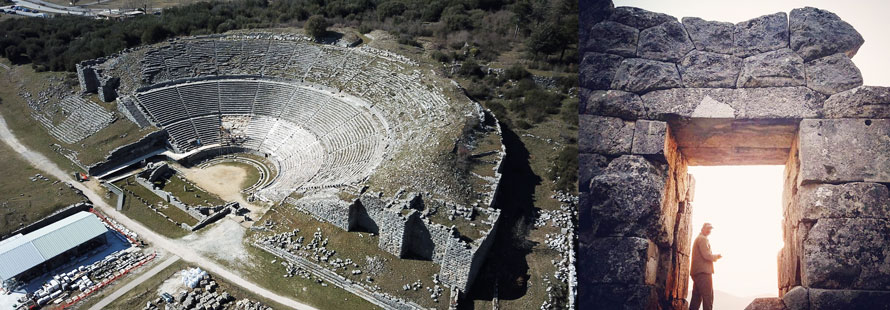
Day 8 - Wednesday 14th October: The Necromanteion was an ancient temple dedicated to the god of the Underworld, Hades, and his consort, the goddess Persephone. It was an entryway to the underworld, and a place where the shades of the dead could - under special circumstances - reveal the future to the living. It was the place that Homer sent Odysseus to seek advice from a long-dead oracle, and where he was horrified by visions of Hades, and it also appears in a sordid chapter of Herodotus’ Histories. Visitors wishing to communicate with the dead would have entered the dark chamber and followed specific rituals outlined for the protection from and communication with the dead which would have taken several days. Pilgrims expected to see the images of the dead as shadows against the flickering lantern light. These visions may have been enhanced by the special diet recommended in the days before entering the sanctuary, which some have described as including hallucinogens. Interestingly, inside the underground chambers, archaeologists have found mechanical contrivances which may have been used to enhance the appearance of animated dead. After a session with the dead, pilgrims were forbidden to talk about what they learned for fear of Hades claiming their own lives in exchange. It is built entirely of beautifully crafted polygonal walls that have an enchanting quality.
After lunch we explore Cassope near Zalongo. It was an ancient Greek city in Epirus. Cassope occupies a magnificent and remote site on a high platform overlooking the sea, the Ambracian Gulf and the fertile lands to the south, and with the slopes of the Zalongo mountain to the north. It is considered one of the best remaining examples of a city built on a rectilinear street grid of a Hippodamian plan in Greece. It has over four miles of polygonal and cyclopean walls and although occupation of the area goes back to paleolithic times, the main part of the city was built in the 4th century BC. Overnight Parga.

Day 9 - Thursday 15th October: Drive to Delphi. Lunch. Afternoon enjoying Delphi Town and optional hike to visit Pan Cave (Corycian Cave). The cave is located on the slopes of Mount Parnassus. In the mythology of the area, it is named after the nymph Corycia. An excavation by French archaeologists in 1969 produced a plethora of objects of antiquity including a rare Neolithic male figurine, Mycenean shards, bone flutes, iron and bronze rings, miniature bronze statues, 50,000 terracotta figurines from the classical period and 24,000 astragaloi, or "knucklebones" (used for astragalomancy, or "prophecy by knucklebones").
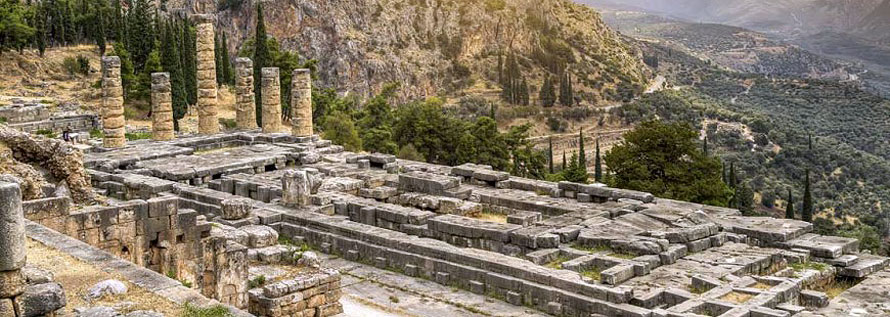
Day 10 - Friday 16th October: Full day exploring all of Delphi, such as the Castalian spring, Apollo Sanctuary, the Sibyl Rock, where oracles were given out from and the Museum. Delphi, formerly called Pytho, is the ancient sanctuary that grew rich as the seat of Pythia, the oracle who was consulted about important decisions throughout the ancient classical world. The ancient Greeks considered the centre of the world to be in Delphi, marked by the stone monument known as the omphalos (navel). It has numerous temples spread out over a vast area including some polygonal walls and evidence of high technology. The great Athena and Apollo energy lines go through the site. Earlier myths include traditions that the Delphic oracle, already was the site of an important oracle in the pre-classical Greek world (as early as 1400 BC) and, rededicated from about 800 BC, when it served as the major site during classical times for the worship of the god Apollo. Apollo was said to have slain Python, a "drako" a serpent or a dragon who lived there and protected the navel of the Earth, echoing the story of St. George. We will also visit the Castalian spring, that still shows the preserved remains of two monumental fountains that received the water from the spring. It dates to the Archaic period and the Roman era, with the latter cut into the solid rock. Farewell Dinner included.

Day 11 - Saturday 17th October: Drive to Athens airport. End of tour, or continue to Crete and Santorini add-on
Santorini and Crete Add-On
Day 1 - Saturday 17th October: (Day 11 of Greece Tour) - Fly to Santorini from Athens (included). On this part of the tour we explore Santorini, the old island of Thera, and explore the Minoan civilization of ancient Crete. On Crete there are the 5.7 million year old Trachilos footprints that resemble modern human feet, so we will try to get a chance to look at those. Dinner and overnight in hotel in Santorini.
Day 2 - Sunday 18th October: Visit Akrotini and Oia. Akrotiri is a Minoan Bronze Age settlement on the volcanic Greek island of Santorini (Thera). The settlement was destroyed in the Theran eruption sometime in the 16th century BC and buried in volcanic ash, which preserved the remains of fine frescoes and many objects and artworks. The settlement has been suggested as a possible inspiration for Plato's story of Atlantis. After exploring the beautiful town of Oia, we take the ferry to Crete.
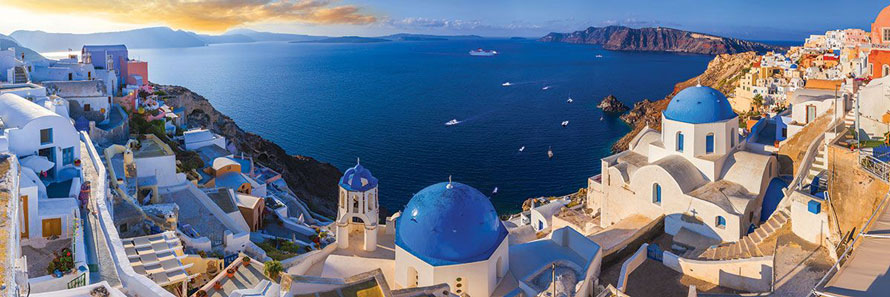
Day 3 - Monday 19th October: Visit Knossos, the Cave of Zeus, and Heraklion Archaeological Museum, and after lunch, the Malia Palace. Knossos, is the largest Bronze Age archaeological site on Crete and has been called Europe's oldest city. Settled as early as the Neolithic period, the name Knossos survives from ancient Greek references to the major city of Crete. The palace of Knossos eventually became the ceremonial and political centre of the Minoan civilization and culture. The palace was abandoned at some unknown time at the end of the Late Bronze Age, c. 1,380–1,100 BC. The reason why is unknown, but one of the many disasters that befell the palace is generally put forward. In the First Palace Period, the urban area reached a size of as many as 18,000 people. In its peak, the palace and surrounding city boasted a population of 100,000 people shortly after 1,700 BC. The site is famous for the mythical labyrinth associated with its inventor Daedalus, King Minos, Princess Ariadne, and Theseus of Athens. Rediscovered by the English archaeologist Arthur Evans in 1901, Knossos is an enormous assemblage of 800 rooms, originally covered with magnificent frescoes, occupying several acres. The Cave of Zeus or Psychro Cave is an ancient Minoan sacred cave in Lasithi plateau in the Lasithi district of eastern Crete. Psychro is associated with the Diktaean Cave, one of the putative sites of the birth of Zeus.

After lunch we visit the newly renovated and expanded Heraklion Archaeological Museum, recently listed as one of the top ten museums in the world. There, we enjoy such spectacular finds as the faience figurine of the Snake Goddess, bull-leaping frescoes, a bull head rhyton, the mysterious Phaistos disc, and several giant labrys, or double-axes from Knossos, which inspired the word labyrinth. Malia Palace, is the third- largest of the Minoan Palaces and is considered the most "provincial" of them. Malia Palace model It covered an area of 7,500 sq.m. and according to tradition the third son of Zeus and Europa, Sarpedon, brother of the legendary king Minos, ruled here.

Day 4 - Tuesday 20th October: Visit Phaistos, Matala and other Minoan sites. Farewell Dinner. Phaistos (sometimes spelt Phaestos, Faistos or Festos) is not as well known as Knossos. It was excavated by an Italian team at the same time as Arthur Evans was digging at Knossos. Evans was very good at what we now call public relations, and so Knossos made far more headlines. He also renovated many of the rooms, which makes them far more interesting for casual visitors. In contrast, nothing in Phaistos remains above the ground floor. But what it may lack in restored features it makes up for in its location. The views of the surrounding countryside especially over the Messara plain are magnificent. Here the enigmatic Phaistos Disc was discovered that may be the Rosetta Stone of ancient Greek civilization, that could be either a lost language or a sophisticated calendar. We also visit the rock-cut cave tombs of Matala. Matala, ancient Matelon, were a port of Phaestus and Gortys and is well known for the carved caves, which were Grecoroman tombs. The cape south of Matala has been identified as Cape Nysos and the location where the ships of Menelaus were wrecked (in Homer's Odyssey). The archaeological site near the village, the kernel of the ancient town, was excavated in the 1980s and brought to light large buildings and workshops of metallurgy, pottery, woodworking, etc. The town seems that flourished from the 6th BC until the 7th AD century. Farewell Dinner.

Day 5 - Wednesday 21st October: Depart for airport for flight to Athens. End of Tour.
Tour Costs: |
£400/£300 GBP deposit to confirm your place This will be converted into your currency at checkout. |
Price includes Price does not include |
Conditions: |
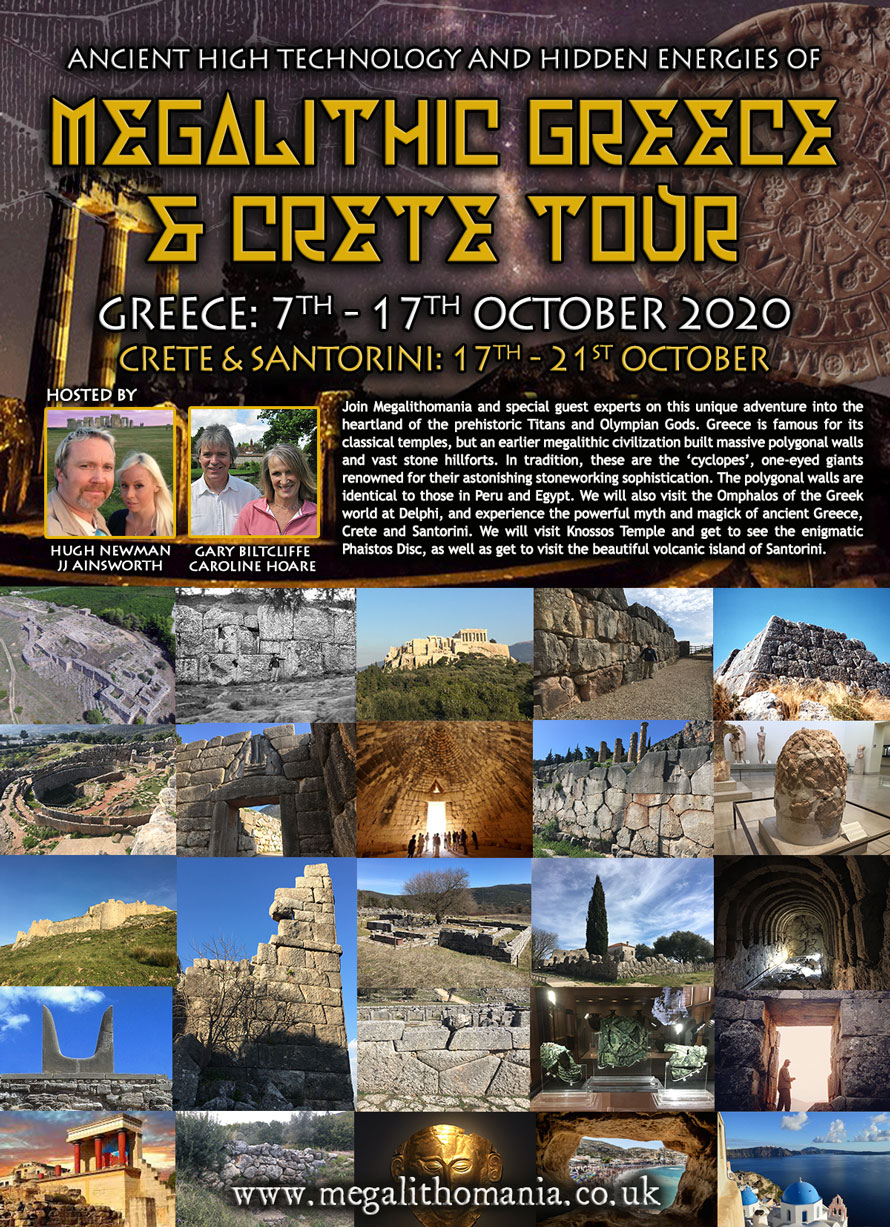
 Hugh Newman is an explorer, megalithomaniac and author of Earth Grids: The Secret Pattern of Gaia’s Sacred Sites (2008), Stone Circles (2017) and co-author of Giants on Record (2015) and Megalith: Studies in Stone (2018). He has been a regular guest on History Channel’s Ancient Aliens and Search for the Lost Giants, and has appeared in The Alaska Triangle (Travel Channel), and The UnXplained with William Shatner (History). As well as organising the Megalithomania conferences and tours, he has spoken at events in the UK, Malta, France, Peru, Egypt, Bosnia and North America. He lives near Stonehenge.
Hugh Newman is an explorer, megalithomaniac and author of Earth Grids: The Secret Pattern of Gaia’s Sacred Sites (2008), Stone Circles (2017) and co-author of Giants on Record (2015) and Megalith: Studies in Stone (2018). He has been a regular guest on History Channel’s Ancient Aliens and Search for the Lost Giants, and has appeared in The Alaska Triangle (Travel Channel), and The UnXplained with William Shatner (History). As well as organising the Megalithomania conferences and tours, he has spoken at events in the UK, Malta, France, Peru, Egypt, Bosnia and North America. He lives near Stonehenge.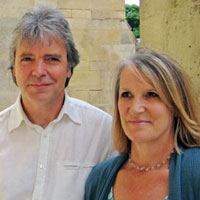 Gary Biltcliffe has dedicated the past 30 years to historical research and investigation of earth mysteries, ancient civilisations and lost knowledge. He has appeared on television and radio and lectured for dowsing and earth mystery groups in the UK, Europe and America. He is the author of The Spirit of Portland: Revelations of a Sacred Isle, co-author of The Spine of Albion: An Exploration of Earth Energies and Landscape Mysteries along the Belinus Line and The Power of Centre: Rediscovering Ancient Cosmology and the Celtic Goddess at the Omphalos Sites of the British Isles. He is also author of the Megalithomania Production DVD The Etruscan Legacy and Megalithic Achievements of Italy based upon a number of research trips over a decade to Italy and Greece researching the mysterious polygonal walls.
Gary Biltcliffe has dedicated the past 30 years to historical research and investigation of earth mysteries, ancient civilisations and lost knowledge. He has appeared on television and radio and lectured for dowsing and earth mystery groups in the UK, Europe and America. He is the author of The Spirit of Portland: Revelations of a Sacred Isle, co-author of The Spine of Albion: An Exploration of Earth Energies and Landscape Mysteries along the Belinus Line and The Power of Centre: Rediscovering Ancient Cosmology and the Celtic Goddess at the Omphalos Sites of the British Isles. He is also author of the Megalithomania Production DVD The Etruscan Legacy and Megalithic Achievements of Italy based upon a number of research trips over a decade to Italy and Greece researching the mysterious polygonal walls. 
